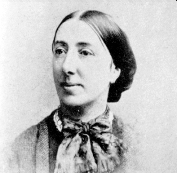Eleanor Anne Ormerod facts for kids
Quick facts for kids
Eleanor Anne Ormerod
|
|
|---|---|
 |
|
| Born | 11 May 1828 Sedbury Park, Gloucestershire, England
|
| Died | 19 July 1901 (aged 73) St Albans, Hertfordshire, England
|
| Nationality | British |
| Scientific career | |
| Fields | entomology, agriculture |
| Institutions | Royal Agricultural College |
Eleanor Anne Ormerod (born May 11, 1828 – died July 19, 1901) was an important English entomologist. An entomologist is a scientist who studies insects. She was one of the first people to focus on how insects affect farming. This field is called agricultural entomology.
Eleanor wrote many important articles about helpful insects and pests. These were published in magazines like the Gardeners' Chronicle and the Agricultural Gazette. From 1877 to 1900, she also created yearly reports. She gathered information for these reports from a network of people across Britain. Eleanor came from a wealthy family and worked for the Royal Agricultural Society of England without pay. She also suggested using a chemical called paris green to kill insects. She even called for getting rid of house sparrows, though this was a debated idea.
Eleanor's Life and Work
Eleanor was born at Sedbury Park, Gloucestershire. Her parents were Sarah and George Ormerod, who wrote The History of Cheshire. From a young age, Eleanor loved studying insects. She had many chances to observe them on her family's large estate. While her brothers went to school, Eleanor was taught at home by her mother.
Her interest in insects grew stronger in 1852 when she found a rare insect. This led her to study books about British beetles. Around 1863, she got a special microscope. This helped her make even more detailed observations. She became an expert in agriculture in her local area. In 1868, the Royal Horticultural Society started collecting farm insect pests. Eleanor helped a lot with this project and received an award called the Flora medal.
In 1877, she published a booklet called Notes for Observations on Injurious Insects. This booklet was a questionnaire sent to people interested in insects. They would then send their findings back to her. This led to her famous Annual Series of Reports on Injurious Insects and Farm Pests. In 1878, she became a member of the Entomological Society of London.
In 1881, Eleanor wrote a special report about the turnip-fly. In 1882, she became a consulting entomologist for the Royal Agricultural Society of England. She held this important job until 1892. For several years, she also taught about scientific entomology at the Royal Agricultural College, Cirencester.
Eleanor's work was known beyond England. She received silver and gold medals from the University of Moscow for her models of insects that harm plants. Her book The Injurious Insects of South Africa showed how wide her studies were. In 1899, she received a silver medal from a French society called the Société nationale d'acclimatation de France.
Some of her other important books include the Cobden Journals, Manual of Injurious Insects, and Handbook of Insects injurious to Orchard and Bush Fruits. A very special honor came to her in March 1900. She received an honorary degree (LLD) from the University of Edinburgh. This was a unique award because she was the first woman to ever receive this degree from the university. The head of the law department praised her work. He said she was like a "beneficent Demeter of the 19th century," meaning she protected agriculture.
Eleanor was also the first woman to become a Fellow of the Royal Meteorological Society in 1878. This society studies weather. Her brother, George Wareing Ormerod, was also interested in weather. Eleanor collected and published a private weather diary from a woman named Miss Caroline Molesworth. This book, called The Cobham Journals, had over 75,000 notes on weather and plants from 1825 to 1850.
In 1897, Eleanor and another scientist, W.B. Tegetmeier, suggested getting rid of house sparrows. However, others disagreed with this idea. One person, Edith Carrington, argued that nature is complex. She believed that trying to change one thing could have many unexpected results.
Eleanor strongly supported bringing Paris Green to Britain from North America. This chemical, made from arsenic, killed most insects. However, it also killed helpful insects like pollinators and predators. This could create a cycle where farmers became more dependent on chemical insecticides. Later, Paris Green was found to be a dangerous product.
After her father passed away, Eleanor and her sisters moved to Torquay. Later, they moved to Spring Grove, Isleworth, to be closer to Kew Gardens. She had good friends there, Sir Joseph and Lady Hooker. In 1887, she moved to St Albans, Hertfordshire, with her sister Georgiana Elizabeth Ormerod. Eleanor died there on July 19, 1901, after a kidney illness. A special plaque on the building honors her. She was buried in the same grave as her sister Georgiana, who was a scientific illustrator.
Recognition and Legacy
Virginia Woolf wrote a story called Miss Ormerod in 1924, which was based on Eleanor's life. Eleanor Ormerod's portrait hangs in the Old College, University of Edinburgh. It proudly shows her as the first woman to receive an honorary degree from the university. In 2017, the University of Edinburgh named their research cloud computing service "Eleanor" after her.
Eleanor Ormerod's name was also used for a RepRap Ormerod 3D printer.
See also
 In Spanish: Eleanor Anne Ormerod para niños
In Spanish: Eleanor Anne Ormerod para niños


